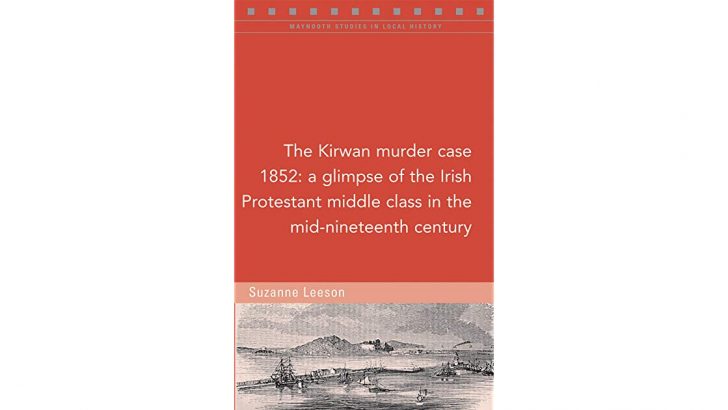The Kirwan Murder Case, 1852: a glimpse of the Irish Protestant middle class in the mid-nineteenth century
By Suzanne Leeson (Maynooth Studies in Local History/Four Courts Press, Dublin, €9.95)
Ian d’Alton
The Maynooth Studies in Local History is a prodigious series of scholarly works (this is number 141) focusing on the local as illuminating wider themes.
It is a respected source, not least because of the rigorous academic standards applied to its contributors – a feature often lacking in local histories. Not here.
This short book is excellently-written, sharply-observed and wide-ranging, a rattling example of good ‘narrative’ history.
It’s a murder-mystery but, as the author points out, it is not the study’s purpose ‘to finally reveal the truth…’ but rather to see it as a window into the middle-class mores and moral viewpoints of post-Famine Protestant Dublin – a city in which Protestants accounted for 30% of the population, and a significant majority of its professional and business classes.
Analysis
Its analysis covers such as the place of religion in Ireland, the nature of transportation, the consciousness by government of public opinion, the role of women – and the salaciousness of society.
William Kirwan, a Protestant, was an artist and medical illustrator, living in Upper Merrion Street. He owned houses in the city and some land in Longford.
He earned substantial sums as a medical draughtsman, and had social as well as professional connections with the city’s medical elite, then substantially Protestant.
Kirwan was married to a Catholic woman, Sarah Crowe; and in 1852 he was convicted of her murder on Ireland’s Eye island, largely on circumstantial and rather dodgy medical evidence. He was sentenced to death, but the sentence was commuted to transportation for life. He spent 27 years in Bermuda, unsuccessfully petitioning for release (Isaac Butt was his lawyer) until, in 1879, he finally returned to Ireland.
The case attracted national and international attention, not least because it was revealed that Kirwan had an ‘alternative family’ with one Theresa Kenny – he had set her up in salubrious Sandymount, the relationship had lasted 12 years, and there were no less than seven children.
The case thus threw up a tangled web of marriage, mistress and religion. Sarah was encouraged by Kirwan to exercise her Catholicism; but it seems that Kenny converted to Anglicanism during her relationship with him, causing a rift with her siblings.
He was sentenced to death, but the sentence was commuted to transportation for life”
The question of who converted to what, and when, was discussed at length, and confusingly, in the newspapers – it wasn’t even clear that Kirwan had perhaps been a ‘cradle Catholic’.
Leeson ably shows how Protestantism, proselytism and anti-popery was a central issue in mid-19th Century Ireland, colouring judgements, reputational and even legal – the religious composition of the jury that tried him was endlessly pored over.
In the words of the Dublin Evening Mail the case itself, had become “an ecclesiastical quarrel”. Or maybe, to be more accurate, a proxy for the embedded sectarian undertow that swirled around Irish society in this period.



